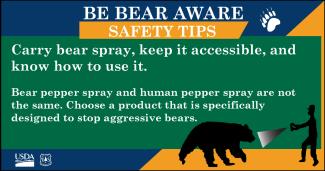Best Practices While Recreating

To AVOID encounters:
- STAY ALERT - especially when your hearing or visibility is limited
- TRAVEL IN GROUPS - all members should stay close to one another
- MAKE NOISE - clap, sing, etc., but the human voice is best!
- CARRY BEAR SPRAY in an accessible place and KNOW HOW TO USE IT
- AVOID traveling at night, dawn, or dusk - bears are most active at these times
- AVOID carcasses - look and listen for scavengers (ravens, magpies, jays, etc.)
Camping Best Practices
Select a campsite away from animal trails, thick brush, and bear food sources such as berry patches and fish spawning streams.

Keep a clean camp. The Custer Gallatin Food Storage Order has specific requirements for managing food and beverages, garbage, and other attractants; be sure to know what the requirements are before you go camping on the Forest.
Don’t leave food, garbage, or other attractants unattended, even for a short period of time. Store these items in accordance with the Food Storage Order if you are more than 100 feet away or do not have a clear line of sight to the items.
Don’t burn food scraps, garbage, or other items with odors in your campfire.
Never leave food, garbage, or other odorous items (e.g., toothpaste, perfume, pet food, etc.) in your tent or sleep with these items in your tent!
Never feed bears (or other wildlife)!
Hunting Best Practices
Carry bear spray, keep it accessible, and know how to use it. Since you are trying to be quiet while pursuing game, be extra aware of your surroundings.

Consult the Custer Gallatin Food Storage Order for specific requirements related to harvested animal carcasses and animal parts in the field.
Field dress and remove the carcass or remove all edible meat from a downed animal as quickly as possible. Move the meat away from the carcass/gut pile, preferably 100-150 yards away. The longer the carcass is in the woods, the more likely it will attract a bear.
If you must leave meat in the field, place it where you can observe it from a distance when you return, preferably from a point several hundred yards away. When you return, observe the meat and surrounding vegetation from a distance, make noise, and approach the area slowly with bear spray ready.
Never attempt to take a carcass from a bear that has “claimed” it!
Carcass Management
- Remove the entire carcass or remove all edible meat from a downed animal as quickly as possible
- Move the meat away from the carcass/gut pile, preferably 100-150 yards away
- If you must leave meat in the field (while packing out a load or overnight), hang it at least 10 feet above the ground and 4 feet from adjacent trees and well away from the gut pile/carcass.
- If you must leave meat in the field, place meat where you can observe it from a distance when you return, preferably from a point several hundred yards away
- When you return, observe the meat and surrounding vegetation from a distance – If it has been disturbed or there is a bear in the vicinity, leave the area and report it to Montana FW&P
- Be sure that any carcass, gut pile, or edible meat that is left in the field or in camp is stored/secured in a location and manner that is consistent with the Custer Gallatin National Forest Food Storage Order
Running and Biking
Mountain biking and trail running are high risk activities. Fast movement can trigger a chase response in bears. The quiet, fast nature of running and biking can result in a close quarters surprise encounter! See the biking in bear country brochure for more information.
When riding or running in bear country:
- Stay alert and scan the trail ahead
- Slow down where visibility is reduced
- Make noise to alert bears to your presence
- Travel in a group and stay together
- Carry bear spray on your person (NOT on your bike!)
- Avoid riding or running at dawn or dusk when bears are most active
If you encounter a bear while riding or running:
- Do not try to outrun the bear!
- Stop, get off your bike, and stand your ground
- Get your bear spray out and remove the safety - bear spray is effective to about 25 feet; spray any threatening bear that is within range
- If the bear appears agitated or upset, be calm and quiet, use your spray if the bear is within range, and only "play dead" {lay on your belly and protect the back of your head and neck with your hands) if the bear makes contact or is about to make contact with you
- If the bear appears calm or interested, act aggressively {yell, throw things, look big), use your spray if the bear is within range, and never play dead with a calm {possibly predatory) bear ... if a calm or curious bear makes contact or is about to make contact with you, fight back!


